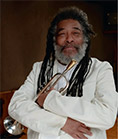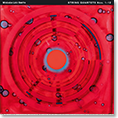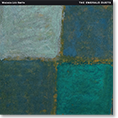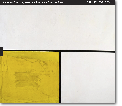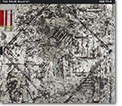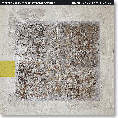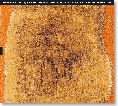THE MUSIC
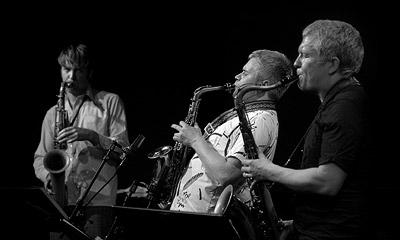
Clustrophy introduces us to a new incarnation of Mikko Innanen & Innkvisitio that released its first recording Paa-da-pap (TUM CD 019) in 2007. Whereas Paa-da-pap featured a quartet of Finns, with saxophonist Timo Lassy as Innanen´s frontline partner, Clustrophy show-cases a five-piece band with a truly pan-European threesome of saxophonists: Mikko Innanen from Finland, Fredrik Ljungkvist from Sweden and Daniel Erdmann from Germany. Luckily for us, the rest of the group remains intact with Seppo Kantonen on synthesizers and Joonas Riippa on drums.
After Innanen founded Innkvisitio in 2004, the original quartet went through an extensive rehearsal period that culminated in a Finnish tour in 2006 that, in turn, resulted in the live recordings heard on Paa-da-pap. In that two-year period, Innkvisitio became a tightly-knit unit with its own distinctive sound and approach to group interplay. Although Innanen is the nominal leader of the group, Innkvisitio has from the beginning been a truly collaborative venture. After Lassy´s departure to focus on his own music, the group´s modus operandi changed in a way that has made it even more exciting. Innanen, Kantonen and Riippa became the nucleus of the group that rehearses and prepares new material together. Although it is Innanen who suggests new compositions or improvisational vehicles to Kantonen and Riippa , after that, it becomes a collective effort. Based upon this groundwork, either one or two additional saxophonists are then brought in to complete the group.
In part, this new approach was the result of happenstance. After Timo Lassy had moved on, Innanen first approached Fredrik Ljungkvist asking him to join Innkvisitio for the tour that coincided with the release in Paa-da-pap in 2007. For Innanen, this choice was fairly easy as Ljungkvist, like Lassy, plays the tenor saxophone as his principal instrument (with the clarinet as an added bonus) and is also stylistically a perfect fit for Innkvisitio. This also gave Innanen an opportunity to play with Ljungkvist, something he had been looking forward to doing for a number of years. According to Innanen, one great attribute of Ljungkvist´s playing lies with the fact that he has quite a different approach to his two principal instruments: "Fredrik´s tenor playing in particular is really strong and energetic although he does not take it too far and always leaves space for the music to breathe. With the clarinet, on the other hand, Fredrik´s playing can be softer, with the focus being on the beautiful wooden sound that he gets from the instrument. Because of his background in free improvisation, including his involvement with the Chicago crowd, Fredrik was a natural for our type of music."
In Erdmann, Innanen found another sympathetic voice who immediately came to mind when Ljungkvist had a scheduling conflict and could not participate in an Innkvisitio tour in France in 2007. Although Innanen and Erdmann were old acquaintances they had not really played together before the tour as Innanen had only come to know Erdmann because of his collaborations with two guitarists, Kalle Kalima and Jaak Sooäär, who are also close to Innanen. However, during the French tour, it became obvious that Erdmann too fit right in and, following the tour, Innanen now had at his disposal two skilful fellow saxophonists who had become familiar with Innkvisitio´s approach and repertoire. Innanen says that, as a saxophone player, Erdmann is complimentary to Ljungkvist: "Daniel is a slightly different player from Fredrik both in terms of his background and influences and also his sound, which is a bit more mellow. His sound is truly beautiful and he has the ability to throw himself into a situation without over-analyzing it. A really exceptional musician."
The final piece of the puzzle fell in place in 2008, when Innkvisitio was scheduled to perform at the Umeå Jazz Festival. Again, Ljungkvist had a scheduling conflict so Innanen invited Erdmann to join the group in Sweden. At the last minute, Ljungkvist, however, also became available and, instead of two, Innkvisitio ended up with three saxophonists on stage. Literally, without any joint rehearsals as one of them - Innanen cannot quite remember whether it was Erdmann or Ljungkvist - only met the others on stage as the performance was just beginning. This unplanned first encounter of the three saxophonists ended up being so successful that Innanen invited both Ljungkvist and Erdmann to join Innkvisitio for a performance at the Tampere Jazz Happening in Finland in November 2009. The studio sessions that resulted in Clustrophy were recorded immediately following that festival performance. Innanen says that the addition of a third saxophone gave him the opportunity to take a more orchestral approach to some of the music. With three saxophones and Kantonen´s synthesizers, the group at times sounds like a much larger ensemble than it actually is. In this connection, Innkvisitio also largely renewed its repertoire. At the Tampere Jazz Happening, they only played two compositions from Paa-da-pap, the title tune and "Berber," whereas most of the other material was newly or recently composed.
In addition to Innanen, Kantonen and Riippa, the second and the third (if the group is performing as a quintet) saxophone chairs are now filled by a rotating cast that, in addition to Ljungkvist and Erdmann, also includes Liudas Mockunas from Lithuania, who is part of the same circle of musicians as Innanen, Erdmann and Sooäär and was a natural substitution when both Ljungkvist and Erdmann were unavailable. The participation of these alternating saxophonists in Innkvisitio introduces additional freshness to the proceedings as they each bring their individual styles to the group´s music.
The nucleus of Innkvisitio formed by Innanen, Kantonen and Riippa has become increasingly close because of the past several years of playing and hanging out together, whether touring with Innkvisitio in Canada, Denmark, Estonia, France, Germany, Hungary, Lithuania, Norway, Sweden and the United States or otherwise. Their close musical and personal relationships have enriched the playing of each member of the trio and have resulted in a series of duo encounters as well. Kantonen and Riippa now perform as an organ-drums duo under the name Kahden Miehen Galaksi or Two-Man Galaxy. Similarly, Innanen and Riippa occasionally perform together as a duo and as two members of the trio Plop (with bassist Ville Herrala being the third member). Even Innanen and Kantonen have recently begun to perform as a duo so all possible combinations have now been exhausted.
Innanen could not be happier with his Finnish colleagues saying of Kantonen that "Seppo always manages to find fresh and surprising sounds and ideas that I could never have thought of while composing. He can also generate new energy if ever the music starts threading water. With the synthesizers, Seppo can dig out an unlimited array of surprising sounds. He never goes for the obvious. Whenever I have composed a tune with a preconception of what Seppo might be playing on it, he has come up with something different. Strange and unusual choices that almost always end up fitting right in."
Innanen calls Riippa "the most unselfish player who also happens to be one of the most creative and swinging drummers on the contemporary scene." He says that "Joonas has always been an exceptionally musical player. In a way, it does not matter what instrument he plays as it always enriches the music. In recent years, he has also become a more confident and much freer musician. He is that ideal drummer who always listens to what the others are playing - where the music is going - but still has the ability to swing and keep the rhythm steady. Joonas is really into collective improvisation and not so interested, for example, in playing drum solos."
Although, when looking at the biographies of its members, Innkvisitio could be seen as a product of the conservatory network that churns out jazz musicians in increasing numbers all over Europe, this would be placing the emphasis on the wrong thing. While it is true that, with the exception of Kantonen who chose not to pursue academic studies, the members of the group have all participated in the jazz programs of prominent conservatories in their respective home countries, it could almost be said that their personal styles of expression and the music on this recording have been developed despite that fact rather than because of it. From early on, Innanen and his compatriots have been following their own path rather than succumbing to the current, somewhat sterile definition of what jazz is supposed to sound like. Most certainly, the music on this recording sounds like nothing else you ever heard, with the exception of Paa-da-pap where the basic concept was already in place. However, Clustrophy introduces a new, somewhat darker and more sophisticated, soundscape to the music, in part because of the evolution of the group´s personnel and the music it plays and perhaps also in part because Clustrophy was recorded in a studio rather than being recorded live as its predecessor.
Mikko Innanen himself feels that his generation of improvising musicians faces a different challenge compared to that of their predecessors. Like all the members of Innkvisitio, they have often started playing music at a young age and, through their attendance in music schools and various jazz programs, have not only become fluent on their chosen instruments but have also developed into skilful interpreters of jazz of the decades past. Unlike their predecessors, the young musicians of today have immediate access to the entire history of jazz both in recorded and in notated form - with Youtube videos to boot - as well as highly sophisticated instruction and guidance from their teachers. With this onslaught of information and influence, it is easy for these young musicians to loose their own individuality and settle for the conventional rather than reaching for something uniquely of their own.
No such fear here. Innanen himself, while respectful of the tradition of the music, has responded to this challenge, in Innkvisitio and otherwise, by consciously seeking to take his own music into areas new and unchartered. In the past, he has characterized the music of Innkvisitio as "retro-futuristic," meaning that it represents a re-examination of the history of jazz as it might have developed from its historic roots had the music taken a different turn sometime in the past, embracing the novel and inventive rather than the stale and repetitious. This gives Innkvisitio the luxury of being oblivious to the commercial trends of today´s music and rather enables them to combine elements from the various phases in the history of jazz with their own music. While the music is strongly routed in history, it is also totally contemporary and futuristic. Although Innanen´s characterization of Innkvisitio´s music as retro-futuristic may sound like a programmatic declaration, he denies this by saying that "there is no hidden agenda - what you hear is what it is." However, one is left suspecting the full accuracy of this and, when pressed, Innanen acknowledges that there may well be something of a hidden agenda after all. Ultimately, this is left for the listener to ponder. Maybe, it does not matter.
Helsinki, October 12, 2010
Petri Haussila
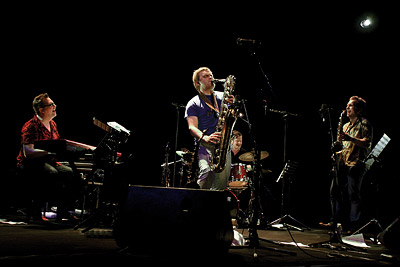
All compositions on this recording are by Mikko Innanen except as otherwise indicated below. The following includes his personal observations on the compositions and their background.
Earth´s Second Moon (3753 Cruithne)
(Mikko Innanen, Seppo Kantonen and Joonas Riippa)
"A collective composition by Seppo, Joonas and myself, ‘Earth´s Second Moon´ launches us into a parallel orbit. Dedicated to Kimmo Innanen and his family in Canada."
Vraa-Tender (Mikko Innanen)
"I was fortunate enough to study with master musician and composer Yusef Lateef in Vrå (Vraa), Denmark, in August 2008. Originally, a composition assignment for Dr. Lateef, ‘Vraa-Tender´ mixes the modern Japanese scale with clustonic harmony. The listener may also notice a little nod to Billy Strayhorn." Tenor saxophone solo: Fredrik Ljungkvist.
Clustrophy (Mikko Innanen)
"Also a composition assignment for Dr. Lateef, this 18-bar composition is based on the nine-tone row already introduced in ‘The Grey Adler Returns´ and ‘Knuf-Aharupa´ on Paa-da-pap. This time, the nine-tone row is carried in the bass line while the three saxophone parts are constructed following the clustonic principles as I understand them. Rhythm-wise, ‘Clustrophy´ owes a little something to Thelonious Monk." Solo order: Daniel Erdmann, tenor saxophone; Mikko Innanen, baritone saxophone; and Seppo Kantonen, synthesizer.
A Panoramic View from the Top Floor (Mikko Innanen)
"Composed in Antwerp, Belgium, in January 2009, this two-part suite features Fredrik Ljungkvist on the clarinet in the first part and Joonas Riippa on the drums in the second part. I was most certainly following some very strict compositional rules in writing ‘A Panoramic View from the Top Floor´ but, rather than getting too theoretical about it, would like to describe the view instead: On the left side, you can see a big church, probably from the 18th century. On the right side, the church is contrasted by backyards of residential buildings with their green gardens and white plastic chairs. The sky is light blue with some white and grey clouds drifting along."
Underground (Mikko Innanen)
A solo baritone saxophone improvisation by Mikko Innanen.
The Grey Adler Returns Again (Mikko Innanen)
"A sequel to ‘The Grey Adler Returns´ on Paa-da-pap, ‘The Grey Adler Returns Again´ was composed in Antwerp in the spring of 2009. The melody is built on a nine-tone row while, in the background, the emphasis is on creating a rhythmic counterpoint to the melody. I firmly believe that this may well be the last of the Grey Adler." Solo order: Seppo Kantonen, synthesizer; Fredrik Ljungkvist, tenor saxophone; and Mikko Innanen and Daniel Erdmann, baritone saxophones.
Ardennes at Dawn (Mikko Innanen)
"‘Ardennes at Dawn´ was composed in Helsinki in August 2009. I am playing the melody on a wooden clarinet made in India. The composition is based on the instrument´s basic set of notes: G, Bb, C, D and F#. Fredrik and Daniel play freely around the melody on clarinets (Fredrik on a real Bb-clarinet, Daniel on a real toy clarinet) while Seppo and Joonas enrichen the soundscape in a special way. This is not a particularly happy tune."
Jantaraboon II (Mikko Innanen)
"Yes, there was a ‘Jantaraboon I´, but it is really nothing much to talk about. However, the basic harmonic structure of ‘Jantaraboon I´ was used as a starting point in creating ‘Jantaraboon II´, a 19-bar semi-clustonic swinger with a mysterious, Oriental undertone. ‘Jantaraboon II´ was composed in the Southern part of Antwerp in the Spring of 2009." Solo order: Mikko Innanen, alto saxophone; Fredrik Ljungkvist, tenor saxophone; and Daniel Erdmann, tenor saxophone.
Detto the Magician (Seppo Kantonen)
A solo synthesizer improvisation by Seppo Kantonen.
757 (Mikko Innanen)
"‘757´ is one of the oldest and most frequently performed compositions in the Innkvisitio repertoire, composed in my yellow room in Helsinki back in 2004. It did not quite make it to Paa-da-pap, perhaps fortunately so, because later it has developed into something of which we had no idea in the first instance." Solo order: Mikko Innanen, alto and soprano saxophones; and Fredrik Ljungkvist, tenor saxophone."
Jam Afane (Mikko Innanen, Daniel Erdman, Seppo Kantonen and Joonas Riippa)
"Goodbye, parallel orbit! A collective, instant composition by Daniel, Seppo, Joonas and myself, ‘Jam Afane´ brings us back to wherever it was we departed from. Andre Ze Jam Afane makes a special guest appearance via Daniel´s mobile phone."

